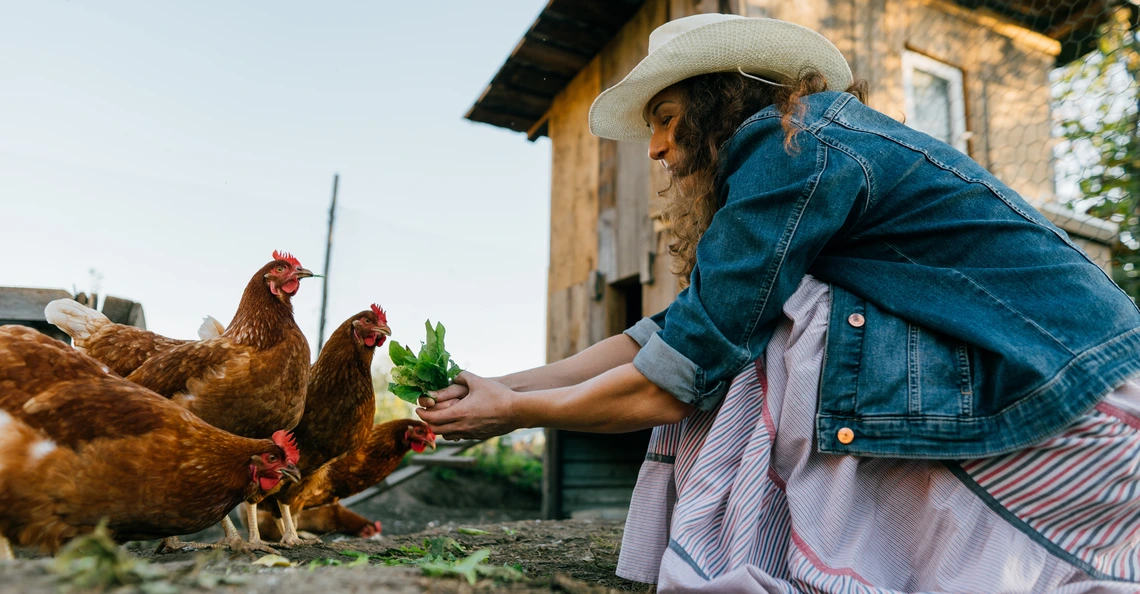Managing chickens in extreme heat
Chickens need sun, but be careful. Too much can be deadly.

Adobe Stock
The most basic and important needs are shade, water, and ventilation.
Chickens should have a place to get out of the sun when they begin to get too warm. This may be trees or specifically constructed shades. Ensure that the shady place has proper ventilation. The insides of small coops or other enclosed buildings can get very stuffy. Ideally, hens will have a more ventilated shaded area, but if that is the only source of shade a fan can help move air around.
Chickens should always have access to fresh, clean, cool water, especially in the summer heat.
Provide multiple water sources located in shady, cool areas if possible to encourage hens to drink. Add ice cubes, ice blocks, or frozen water bottles if needed to keep water cool. Low sided dishes or pans will allow hot chickens to wade in and cool their feet. It is important to change open water daily to prevent coccidiosis from spreading. It is not uncommon to see extremely watery droppings during periods of high heat due to increased water consumption.
Misters are another way chicken keepers cool their flocks. The dry Arizona weather lends itself well to evaporative cooling. A simple, standalone mister that attaches to a garden hose can be purchased for around $12. Set up the mister in a shady area near a water supply.
If you choose to set it up inside the coop or run, use caution that it doesn’t soak feed bins or overly saturate the coop floor. A slightly damp floor is cool and refreshing, a sopping wet swamp breeds disease and attracts pests.
Feed consumption during extreme heat waves will likely go down; a hot chicken will have a decreased appetite.
For this reason, it's important to limit treats and extras (especially scratch grains). Treats should be aimed to increase hen hydration without further decreasing consumption of lay rations. Things such as frozen watermelon or fruits/veggies chopped and frozen into a block work to keep hens cool and busy without excessively filling them up. Feeding hens layer rations in the early morning or late evening when temperatures are lower will aid in increasing feed consumption.
Egg production will likely decrease during periods of extreme heat due to decreased feed intake.
Reduced intake also leads to reduced calcium which could negatively affect eggshell quality. Eggs should be picked up even more often in extreme heat waves. Most hens will lay early in the day, picking them up as soon as possible is best from a food safety standpoint and will help prevent hens from going broody.
Nesting areas that lack ventilation could subject hens to heat stress while laying (especially if they go broody). Ventilate nest boxes as much as possible. If necessary, during extreme heat waves block them off and provide temporary alternate laying arrangements (such as open milk crates in a cooler, more ventilated area).
If possible, don't allow hens to go broody. Broody hens often only leave the box once a day to eat, drink, and eliminate. A broody hen is much more susceptible to heat stress and exhaustion due to her decreased water intake.
Like dogs, hens do not sweat. Heat loss is achieved through respiration. A “hot” hen may be seen panting lightly, but otherwise will be running around acting normal. A hen under light or moderate heat stress may pant more heavily. She will also hold her wings away from her body and crouch slightly to aid in heat dissipation through the unfeathered areas under her wings.
These hens are not in immediate danger, but should be moved to a cooler area with shade and water to prevent heat exhaustion.
A hen in danger of heat exhaustion will be panting heavily and holding her wings away from her body. She may have a pale waddle and comb, she may be lethargic, limp, or unconscious. A chicken exhibiting these symptoms is in extreme danger of dying from heat stress and needs to be cooled quickly. Submerge her body (not her head) in a bucket of cool (not icy) water and place her somewhere cool such as in the house until she is completely recovered.
Preventing heat stress is much easier than treating it.
Have a plan to help your birds during the peak of summer. Even if you aren’t able to be home during the day, ice blocks or bottles placed out in the morning will last most of the day and misters can be set up on a simple timer to come on when temperatures begin to climb.
With just a little help, backyard birds can make it through the high temperatures of summer unscathed.

